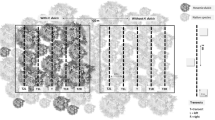Abstract
The floristic characteristics, age structure and survival modes of Tertiary-relic deciduous forests were analyzed at 1600 m on Mt. Emei (3099 m), Sichuan, China. Three plots were selected to represent typical topographies: Plot 1 at 1620 m on a scree slope, Plot 2 at 1640 m on a slope with moderately rocky soils, and Plot 3 at 1616 m on a gentle slope with less rocky soils. At Plot 1, on the scree slope, the forest was rich in species and dominated by Tertiary remnants and other deciduous trees (Davidia involucrata, Styrax hemsleyana, Cercidiphyllum japonicum var.sinense, Pterocarya hupehensis, Prunus brachypoda, Prunus padus, Tetracentron sinense andStaphylea holocarpa). The relic deciduous tree taxaDavidia, Cercidiphyllum, Tetracentron andEuptelea occupied the unstable concave slopes, where evergreen broad-leaved trees (Castanopsis platycantha andMachilus pingii) were rarely able to survive. On the relatively stable convex slopes of this plot, evergreen trees with small diameter mainly appeared in the subcanopy and shrub layers.Davidia involucrata was the dominant species in this forest. On the slope with moderately rocky soils (Plot 2), the forest was co-dominated by relicDavidia and other deciduous (Styrax andPterocarya), and evergreen trees (Castanopsis andMachilus). On the gentle slope with less rocky soils (Plot 3),Davidia trees were found only in the subcanopy and shrub layers, and the forest was dominated byMachilus, Castanopsis, Styrax andPrunus trees. Regeneration ofDavidia occurs mainly on the scree slope where landslides are most common. The age structure of theDavidia stands indicates that this species is able to survive on the unstable scree habitat due to its strong sprouting ability. The Tertiary-relic deciduous forest on the scree slope is seen to be a topographic climax forest.
Similar content being viewed by others
References
Basnet K., Likens G.E., Scantena F.N. &Lugo A.E. (1992): Hurricane Hugo: damage to a tropical rain forest in Puerto Rico.J. Trop. Ecol. 8: 47–55.
Chu K.-L. &Cooper W.S. (1950): An ecological reconnaissance in the native home ofMetasequoia glyptostroboides.Ecology 31: 260–278.
Del Tredici P. (1992): Natural regeneration ofGinkgo biloba from downward growing cotyledonary buds (Basal Chichi).Amer. J. Bot. 79: 522–530.
Drury W.H. &Nisbet I.C.T. (1973): Succession.J. Arnold Arbor. 54: 331–368.
Fu L. &Jin J.-M. (1991):Red data book of Chinese plants. Science Press, Beijing (In Chinese).
Guan Z.-T. &Chen Y. (1986): A preliminary study on the Cathaya mixed forest in Jinfushan, Sichuan.Acta Bot. Sin. 28: 646–656.
He J.-S., Lin J. &Chen W.-L. (1995): The current status of endemic and endangered speciesDavidia involucrata and the preserving strategies.Chin. Biodiversity 3: 213–221.
Horikawa Y. (1972):Atlas of the Japanese flora: an introduction to plant sociology of East Asia. Gakken, Tokyo.
Jiao J. (1995): The quantitative characters ofDavidia involucrata communities in Wen County of Gansu Province.J. Gansu Agric. Univ. 30: 189–193.
Li H.-L. (1954):Davidia as the type of a new familyDavidaceae.Lloydia 17: 329–331.
Lu A.-M. (ed.) (1999):The geography of spermatophytic families and genera. Science Press, Beijing.
Ohsawa M. (1983): Comparative study on zonation of vegetation in East Asia. In:Contemporary Ecology of Japan Compilation Committee (ed.),Contemporary ecology of Japan, Kyoritsu Press, Tokyo, pp. 206–213 (In Japanese).
Ohsawa M. (1984): Differentiation of vegetation zones and species strategies in the subalpine region of Mt. Fuji.Vegetatio 57: 15–52.
Ohsawa M. (1987): Vegetation zones in the Bhutan Himalaya. In:Ohsawa M. (ed.),Life zone ecology of the Bhutan Himalaya, Chiba University, Chiba, pp. 1–71.
Pielou E.C. (1969):An introduction to mathematical ecology. Wiley, New York.
Sakai A. &Ohsawa M. (1994): Topographical pattern of the forest vegetation on a river basin in a warm-temperate hilly region, central Japan.Ecol. Res. (Tokyo) 9: 269–280.
Takahashi K. (1962): Studies on vertical distribution of the forest in middle Honshu.Bull. Gov. Forest Exp. Stat. 142 (In Japanese).
Takhatajan A. (1969):Flowering plants, origin and dispersal. Oliver & Body, Edinburgh.
Tang C.Q. &Ohsawa M. (1997): Zonal transition of evergreen, deciduous, and coniferous forests along the altitudinal gradient on a humid subtropical mountain, Mt. Emei, Sichuan, China.Pl. Ecol. 133: 63–78.
Tang C.Q. (2000):Ecological studies on forest vegetation on a humid subtropical mountain, Mt. Emei, Sichuan, China. Dissertation, Chiba University.
Tokyo University Botanical Garden (2000):Handkerchief tree. Tokyo University, Tokyo (In Japanese).
Veblen T.T. &Ashton D.H. (1978): Catastrophic influences on the vegetation of the Valdivian Andes, Chile.Vegetatio 36: 149–167.
Wang H.-S. (1992):Phytogeography. Science Press, Beijing (In Chinese).
Wu Z.-Y. (1979): On the regionalization of the Chinese flora.Bot. Res. Yunnan Prov. 1: 1–20 (In Chinese with English summary).
Yang Y.-C. &Li T.-J. (1989): Preliminary studies on the phytocommunity ofDavidia involucrata in Emei mountain of Sichuan.Acta Phytotax. Geobot. Sin. 13: 270–276 (In Chinese with English abstract).
Yang Y.-Q. &Xu Y.-Y. (1986): A preliminary study on the ecological characteristics of dove tree in Guizhou Province.Sci. Silvae Sin. 22: 426–430 (In Chinese with English abstract).
Ying J.-S. &Ma C.-G. (1979): The vegetation and flora of Exi Shennongjia region.Acta Phytotax. Sin. 17: 41–60 (In Chinese with English abstract).
Yuan D.-L. &Ban J.-D. (1990):Davidia community of Mt. Qizhimei, Xuanen, and problems of conservation.Environm. Sci. Technol. 3: 38, 45–48 (In Chinese).
Zhang J.-X., Li J.-Q., Zhou B.-S. &Lian X.-R. (1995): Natural distribution ofDavidia involucrata and introduction analysis.J. Beijing Forest. Univ. 17: 25–30 (In Chinese with English abstract).
Zhang Q.-H. (1992): A study of cultivation techniques for dove tree propagation. In:Academy of Forestry (ed.),Propagation techniques for the main precious, rare and endangered trees, China Forestry Press, Beijing, pp. 31–35 (In Chinese).
Zhong Z.-C., Chin Z.-S. &Shi J.-H. (1984): Preliminary studies on the phytocoenological features of theDavidia forests in the Wolong region of Sichuan Province.Acta Phytytotax. Geobot. Sin. 8: 253–263 (In Chinese with English abstract).
Author information
Authors and Affiliations
Corresponding author
Rights and permissions
About this article
Cite this article
Tang, C.Q., Ohsawa, M. Tertiary relic deciduous forests on a humid subtropical mountain, Mt. Emei, Sichuan, China. Folia Geobot 37, 93–106 (2002). https://doi.org/10.1007/BF02803193
Issue Date:
DOI: https://doi.org/10.1007/BF02803193




